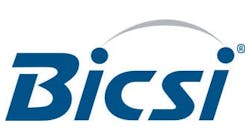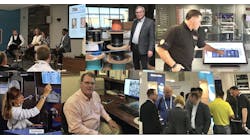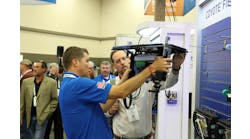5G REALITIES —
How has working toward 5G preparedness and deploying 5G impacted you and your team?
Scot Bohaychyk, Manager, Product Marketing, Clearfield: 5G and all that surrounds it is impacting nearly every company in telecom. At Clearfield, we were aware early that 5G would involve fiber usage at a level that the industry has not experienced. Products like our FieldShield® pre-connectorized pushable fiber and microducts ideally support the needs of 5G densification projects. Specifically, connections in the Radio Access Network (RAN) do not require high fiber counts, but do require a small form factor and easy installation — areas in which Clearfield excels. As 5G projects move from limited deployment to mass market, the Clearfield team stands ready to easily field the increased needs of our 5G customers.
ACCOMPLISHMENT
What network-related project are you most proud of in your career?
COMMUNITIES AND COLLABORATION
Share the best way service providers and communities should collaborate to offer residents the high-speed broadband that is necessary to keep their communities vibrant.
Jeff Chapman, EVP, Operations, NorthState Communications: Our focus has been on building relationships with local Municipalities, Residential/Commercial Developers and Home Owners Associations to address the demand for high-speed services and enhance all aspects of the community. Being able to partner with these entities and promote fiber-based services, which support the demand of Cloud Services and OTT content, is extremely valuable to the home/business owner in today’s environment.
InvisiLight® Solution for Deploying Fiber
April 2, 2022Go to Market Faster. Speed up Network Deployment
April 2, 2022Episode 10: Fiber Optic Closure Specs Explained…
April 1, 2022Food for Thought from Our 2022 ICT Visionaries
April 1, 2022CORE UPGRADES
Since rip-and-replace is not a workable strategy for transforming the legacy core network, what are the best strategies to upgrade the copper plant to deliver fiber-like speeds?
LAYOFFS
When telecom providers lay off employees that care for their wireline networks, what does that mean for both the wireline and wireless networks of the future?
Lisa Truppa, Assistant Vice President – Technology, AT&T: We all understand that wireless can only get so far — at some point you still need the fiber in the ground (i.e., our wireline network). At the same time, all of us are pushing for more efficient ways of maintaining that network so we can afford to deliver the "next G". That means actively driving for automation when it makes sense. That doesn’t mean fewer jobs, necessarily, but rather different jobs. At AT&T, we’re proud to have offered a variety of different upskilling and reskilling programs to our employees over the years.
NETWORK DENSIFICATION
5G will not be able to meet its performance goals without cell densification. In fact, hyper-densification is required to deliver the promise of 5G.
What work still needs to be done in this area?
NETWORK EVOLUTION PAINS
What is your biggest pain point across the wireline and wireless networks?
How can the industry help solve it?
NETWORK OPTIMIZATION
What are some best practices for optimizing the wireline and wireless telecom networks?
Kim Shepherd, CEO, Skyline Membership Corp / SkyBest Communications: There is no magic formula but some of the key processes we use for network optimization include:
Eliminating flat VLANs. A flat VLAN is a network loop / broadcast storm just waiting to happen. When our FTTP network was in its infancy, we had flat VLANs running all over the network. However, we quickly learned how dangerous that can be, and now we eliminate them at all costs.
Keep detailed records. This sounds like a given but having good records is paramount for running a fully optimized network. Knowing what links carry what type of traffic and where those links terminate can mean the difference between calm, routine maintenance and a chaotic, major outage!
Mitigate the failure domain. Whenever possible we push routing and network intelligence as close to our customers as possible. This accomplishes several things including mitigating the failure domain. The thought process is that if we lose a router or an FTTP node near the network’s edge, we will minimize the impact to our customers and our staff as opposed to the outage occurring closer to the network’s core.
OTT AND INFRASTRUCTURE CHALLENGES
Over-the-top (OTT) service growth, fueled by streaming video and public demand for non-linear media consumption is a given. However, with this, further financial and infrastructure pressure will be placed on network operators.
What are some solutions to this problem?
Ben Goth, Vice President of Network Services, TDS Telecom: As user bandwidth consumption continues to rise, providers must change and update their networks to stay ahead of the demands. This places strain on the entire network (including the home and Last Mile) and requires ongoing review in order to adequately forecast planned solutions for swift upgrades. The challenge with forecasting is the need for visibility into where the next major usage spike will be originating, especially when it is caused by non-linear media. Providers must find new ways to optimize the network and how the network is operated. These findings will be critical to providers looking to successfully reduce financial and infrastructure pressures in advance of the next unpredictable over-the-top (OTT) service that will undoubtedly drive increases in bandwidth usage. I’m hopeful AI will provide needed enhancements to forecasting and help in predicting the changes that are difficult (unpredictable) using current tools and methods.
TECHNICIAN FIBER TESTING
With fiber going deeper to prep the foundation for 5G, a shortage of qualified technicians who can efficiently install and test fiber is already being felt. The BT Group alone announced that nearly 3,000 new trainees will be recruited during 2019 to support its fiber deployments. Many of these new employees are completely new to fiber testing, coming from a copper or electrical background.
Is your organization facing something similar? What is your organization doing in this area to train technicians in fiber testing?
WORKFORCE CHANGES
Attracting and keeping top millennial talent is a burning issue for leaders. Millennials are 35% of the workforce. By 2020 they’ll be 46% of the working population.
What do we need to attract and keep young talent in the ICT industry?
YOUR TAKE
Share 1 problem/challenge that you are passionate about solving for the ICT Industry.
Daniel Ashton, Senior Engineer – Electrical Protection (ICEP), CenturyLink: Unstable AC power and unpredictable lightning events make electrical protection of the communication industry facilities paramount. As a CenturyLink Inductive Coordination and Electrical Protection Engineer, this area of network reliability is my team’s responsibility. Proper grounding, bonding and surge protection installation are critical to protecting network equipment from damage and avoiding major service outages.















